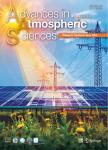Ensemble Forecasts of Tropical Cyclone Track with Orthogonal Conditional Nonlinear Optimal Perturbations
Ensemble Forecasts of Tropical Cyclone Track with Orthogonal Conditional Nonlinear Optimal Perturbations作者机构:National Meteorological CenterChina Meteorological Administration State Key Laboratory of Numerical Modeling for Atmospheric Sciences and Geophysical Fluid DynamicsInstitute of Atmospheric Physics Chinese Academy of Sciences University of Chinese Academy of Sciences Laboratory of Cloud-Precipitation Physics and Severe Storms Institute of Atmospheric PhysicsChinese Academy of Sciences
出 版 物:《Advances in Atmospheric Sciences》 (大气科学进展(英文版))
年 卷 期:2019年第36卷第2期
页 面:231-247页
核心收录:
学科分类:07[理学] 0706[理学-大气科学] 0816[工学-测绘科学与技术] 0825[工学-航空宇航科学与技术] 0702[理学-物理学]
基 金:jointly sponsored by the National Key Research and Development Program of China (2018YFC1506402) the National Natural Science Foundation of China (Grant Nos.41475100 and 41805081) the Global Regional Assimilation and Prediction System Development Program of the China Meteorological Administration (GRAPES-FZZX2018)
主 题:ensemble forecast initial perturbation conditional nonlinear optimal perturbation tropical cyclone
摘 要:This paper preliminarily investigates the application of the orthogonal conditional nonlinear optimal perturbations(CNOPs)–based ensemble forecast technique in MM5(Fifth-generation Pennsylvania State University–National Center for Atmospheric Research Mesoscale Model). The results show that the ensemble forecast members generated by the orthogonal CNOPs present large spreads but tend to be located on the two sides of real tropical cyclone(TC) tracks and have good agreements between ensemble spreads and ensemble-mean forecast errors for TC tracks. Subsequently, these members reflect more reasonable forecast uncertainties and enhance the orthogonal CNOPs–based ensemble-mean forecasts to obtain higher skill for TC tracks than the orthogonal SVs(singular vectors)–, BVs(bred vectors)– and RPs(random perturbations)–based ones. The results indicate that orthogonal CNOPs of smaller magnitudes should be adopted to construct the initial ensemble perturbations for short lead–time forecasts, but those of larger magnitudes should be used for longer lead–time forecasts due to the effects of nonlinearities. The performance of the orthogonal CNOPs–based ensemble-mean forecasts is case-dependent,which encourages evaluating statistically the forecast skill with more TC cases. Finally, the results show that the ensemble forecasts with only initial perturbations in this work do not increase the forecast skill of TC intensity, which may be related with both the coarse model horizontal resolution and the model error.



